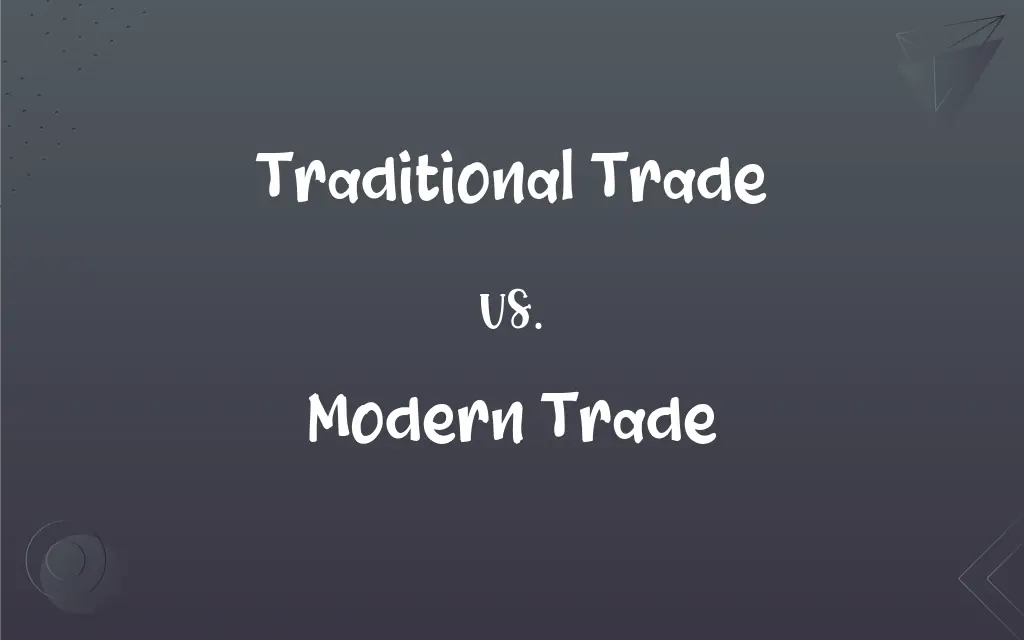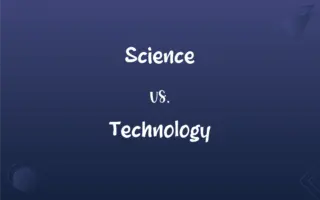Traditional Trade vs. Modern Trade: What's the Difference?
Edited by Aimie Carlson || By Harlon Moss || Updated on October 2, 2023
Traditional trade involves small-scale, localized transactions, often in open markets. Modern trade involves larger, often global transactions, utilizing technology and formalized business structures.

Key Differences
Traditional trade typically refers to a setup where transactions are performed in a more personalized and localized manner. Here, modern trade refers to a more organized, technologically driven and often expansive trading platform that emphasizes a depersonalized trading experience, focusing on efficiency and scale.
In traditional trade, interactions between buyers and sellers often happen face-to-face, fostering relationships and trust. On the other hand, modern trade often leverages digital platforms and technology, making transactions faster and more efficient, albeit with less personal interaction.
Traditional trade can be characterized by its smaller scale, often involving smaller businesses or markets that cater to a local customer base. In contrast, modern trade, with its emphasis on technology, tends to operate on a much larger scale, sometimes crossing international boundaries and reaching a global customer base.
Payments in traditional trade are often straightforward, occasionally involving physical currency or straightforward payment methods. On the flip side, modern trade extensively utilizes various digital payment platforms, providing diverse payment options and sometimes offering credit facilities.
Supply chains in traditional trade tend to be shorter and simpler, with products often moving directly from producer to consumer. In stark contrast, modern trade often involves complex, global supply chains that can span multiple countries and involve numerous intermediary stages and entities.
ADVERTISEMENT
Comparison Chart
Scale
Small and localized
Large and widespread
Technology Usage
Minimal or non-existent
Extensive
Customer Interaction
Personal and direct
Often impersonal
Payment Methods
Simpler, often cash
Diverse, digital
Supply Chain
Short and simple
Complex and global
ADVERTISEMENT
Traditional Trade and Modern Trade Definitions
Traditional Trade
Traditional trade often emphasizes personal relationships between buyers and sellers.
Through traditional trade, Mrs. Lee built strong relationships with her customers.
Modern Trade
Modern trade typically involves various digital and electronic payment methods.
Credit card payments and digital wallets are prevalent in modern trade.
Traditional Trade
Traditional trade commonly operates in physical markets or stores.
The town square was bustling with traditional trade during the festival.
Modern Trade
Modern trade leverages technology and digital platforms for transactions.
E-commerce websites are a significant part of modern trade, facilitating global purchases.
Traditional Trade
Traditional trade generally uses simpler, straightforward payment methods.
In traditional trade, Mr. Smith accepts cash or basic card payments for his goods.
Modern Trade
Modern trade can involve complex, multi-entity supply chains.
Products in modern trade often pass through several countries before reaching consumers.
Traditional Trade
Traditional trade usually involves direct or minimally intermediated supply chains.
Traditional trade in the village connects the fisherman directly to the consumer.
Modern Trade
Modern trade may offer a depersonalized shopping experience due to its scale.
Online shopping, a facet of modern trade, offers convenience but lacks personal interaction.
Traditional Trade
Traditional trade typically involves small-scale, localized transactions.
The farmer sold his produce through traditional trade at the local market.
Modern Trade
Modern trade often operates on a larger, potentially global, scale.
Modern trade enables companies to sell products to customers around the world.
FAQs
What is a key characteristic of traditional trade?
Traditional trade often involves localized, small-scale transactions with direct customer interaction.
Are cash transactions more common in traditional trade?
Yes, traditional trade usually entails more straightforward payment methods, often involving cash or basic card transactions.
Is traditional trade limited to local markets?
Primarily yes, traditional trade typically involves localized transactions and is often concentrated in specific geographic areas or communities.
How does modern trade impact global markets?
Modern trade often involves expansive, sometimes global, supply chains and can connect products and consumers across international boundaries.
How does supply chain management differ in traditional trade compared to modern trade?
Traditional trade usually involves simpler, direct supply chains, while modern trade can involve complex, multi-tiered, and often global supply chains.
Can modern trade operate on a local scale?
While modern trade is often associated with larger-scale operations, it can also operate locally, especially when utilizing digital platforms to reach local consumers.
How does modern trade utilize technology?
Modern trade leverages digital platforms and technological tools for transactions, customer interactions, and supply chain management.
How does modern trade affect customer experience?
Modern trade can offer a wide array of choices and convenience through online platforms but may lack the personalized interaction found in traditional trade.
Is building personal relationships a key component of traditional trade?
Yes, traditional trade often emphasizes building personal relationships between buyers and sellers through direct, face-to-face interactions.
How does modern trade impact product pricing?
Modern trade can impact product pricing through economies of scale, offering a wider array of products, often at various price points, and sometimes providing competitive pricing due to a broader market.
How does traditional trade adapt to market changes?
Traditional trade may adapt to market changes through altering product offerings or adjusting practices based on direct customer feedback and observed purchasing behaviors.
Does modern trade always involve e-commerce?
While e-commerce is a significant aspect of modern trade, modern trade also includes organized retail chains and hypermarkets that utilize advanced business strategies and technologies.
How dependent is traditional trade on geographical location?
Traditional trade is often heavily dependent on geographical locations as it typically caters to local or regional customers and operates in physical marketplaces.
Can modern trade facilitate cross-border transactions?
Yes, one of the hallmarks of modern trade is its ability to facilitate cross-border transactions, often enabled by digital platforms and global logistics networks.
Are traditional trade businesses usually smaller in size?
Often yes, traditional trade businesses tend to be smaller in scale and may be family-owned or small-scale operations catering to a limited customer base.
How flexible is traditional trade in terms of product availability?
Traditional trade may have limited flexibility in product availability, often offering goods that are locally produced or available within shorter supply chains.
Can traditional trade utilize digital payment methods?
While traditional trade often relies on simpler payment methods, it is not restricted from utilizing digital payment options if available and practical.
How important is physical presence in traditional trade?
Physical presence, such as a storefront or market stall, is usually crucial in traditional trade, as it primarily operates through in-person interactions and transactions.
How does modern trade deal with customer feedback?
Modern trade often utilizes digital platforms to gather, analyze, and respond to customer feedback, implementing changes across wide-scale operations accordingly.
Can modern trade offer personalized customer experiences?
While often less personal, modern trade can utilize data analysis to offer personalized marketing, recommendations, and customer experiences on digital platforms.
About Author
Written by
Harlon MossHarlon is a seasoned quality moderator and accomplished content writer for Difference Wiki. An alumnus of the prestigious University of California, he earned his degree in Computer Science. Leveraging his academic background, Harlon brings a meticulous and informed perspective to his work, ensuring content accuracy and excellence.
Edited by
Aimie CarlsonAimie Carlson, holding a master's degree in English literature, is a fervent English language enthusiast. She lends her writing talents to Difference Wiki, a prominent website that specializes in comparisons, offering readers insightful analyses that both captivate and inform.
































































